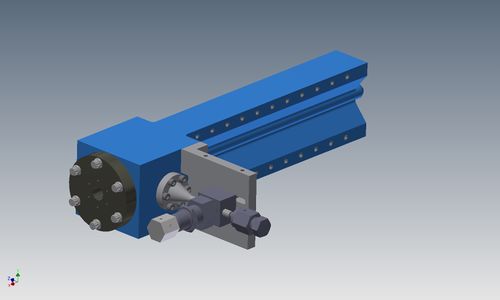Difference between revisions of "Main Page"
| Line 2: | Line 2: | ||
[[file:T2_cell.jpg|right|500px|]] | [[file:T2_cell.jpg|right|500px|]] | ||
The JLAB Hall A Tritium Target (HATT) is expected to be used for a number of approved experiments starting in the Fall of 2017 at Jefferson Lab Continuous Electron Beam Accelerator Facility (CEBAF). The target consists of Five (5) cells of various species of gas (with one being an empty cell) installed in place of the standard Hall A cryogenic target. The gaseous fluid will not be circulated marking a departure from the normal Hall A target operation. | The JLAB Hall A Tritium Target (HATT) is expected to be used for a number of approved experiments starting in the Fall of 2017 at Jefferson Lab Continuous Electron Beam Accelerator Facility (CEBAF). The target consists of Five (5) cells of various species of gas (with one being an empty cell) installed in place of the standard Hall A cryogenic target. The gaseous fluid will not be circulated marking a departure from the normal Hall A target operation. | ||
| − | The intent was to design and construct a simple and robust target system which mitigates the hazards associated with tritium by minimizing the amount of tritium required to perform the experiments and by multiple layers of containment/confinement. The target cells are of a modular design. This allows for easy assembly of the target system and permits installation of the tritium cell after all other target installation activities have been completed. The modular design chosen also allows the tritium cell to be filled off site at Savannah River | + | The intent was to design and construct a simple and robust target system which mitigates the hazards associated with tritium by minimizing the amount of tritium required to perform the experiments and by multiple layers of containment/confinement. The target cells are of a modular design. This allows for easy assembly of the target system and permits installation of the tritium cell after all other target installation activities have been completed. The modular design chosen also allows the tritium cell to be filled off site at Savannah River Site tritium Enterprises (SRTE). This limits the amount of tritium at Jefferson Lab to the amount contained in the cell which is slightly less than 1075 Ci. In effect, Jefferson Lab will not “handle” tritium. The entire target assembly shall be cooled with 15K helium from the End Station Refrigerator (ESR). The 15K helium will be preheated to 40K and used to cool a heat sink attached to the cell assemblies. This will remove the ~15W of heat that is generated by the electron beam. The beam current allowed on the tritium cell shall also be limited to a maximum of 22 µA. |
Revision as of 12:02, 18 October 2017
Tritium Target Wiki
The JLAB Hall A Tritium Target (HATT) is expected to be used for a number of approved experiments starting in the Fall of 2017 at Jefferson Lab Continuous Electron Beam Accelerator Facility (CEBAF). The target consists of Five (5) cells of various species of gas (with one being an empty cell) installed in place of the standard Hall A cryogenic target. The gaseous fluid will not be circulated marking a departure from the normal Hall A target operation. The intent was to design and construct a simple and robust target system which mitigates the hazards associated with tritium by minimizing the amount of tritium required to perform the experiments and by multiple layers of containment/confinement. The target cells are of a modular design. This allows for easy assembly of the target system and permits installation of the tritium cell after all other target installation activities have been completed. The modular design chosen also allows the tritium cell to be filled off site at Savannah River Site tritium Enterprises (SRTE). This limits the amount of tritium at Jefferson Lab to the amount contained in the cell which is slightly less than 1075 Ci. In effect, Jefferson Lab will not “handle” tritium. The entire target assembly shall be cooled with 15K helium from the End Station Refrigerator (ESR). The 15K helium will be preheated to 40K and used to cool a heat sink attached to the cell assemblies. This will remove the ~15W of heat that is generated by the electron beam. The beam current allowed on the tritium cell shall also be limited to a maximum of 22 µA.
Technical Documents
Reports
This page contains several formal engineering reports including the main design document and the response to the review committee reports. A hazard analysis is also included.
Procedures
This page contains links to the engineering procedures applicable to the HATT
Calculations
This page contains links to the engineering calculations applicable to the HATT
Drawings and CAD
This page contains links to the engineering drawings applicable to the HATT
Engineering Change Orders (ECO)
This page contains links to the engineering change orders applicable to the HATT
Test Reports
This page contains links to the engineering test reports applicable to the HATT. This includes burst testing of the cell and formal certification of the exhaust system.
Reviews
This page summarizes the reviews applicable to the HATT and has links to the presentations and other documents.
Presentations
This page contains many of the presentations given for the HATT over the years.
